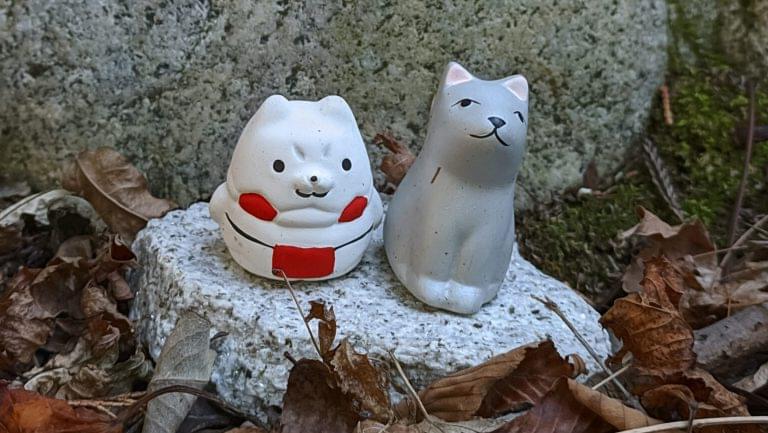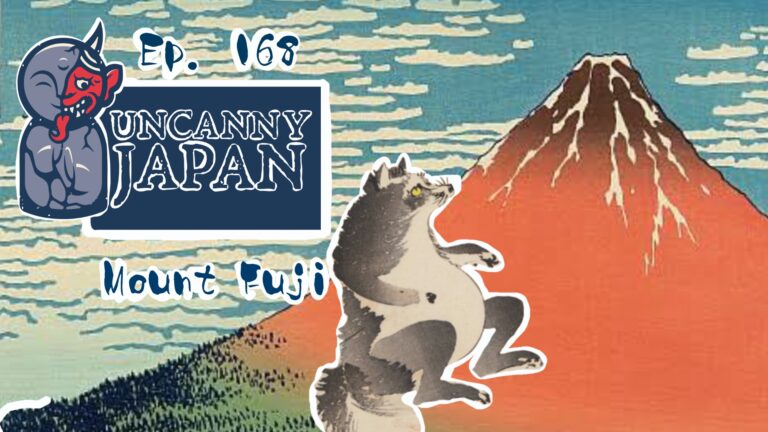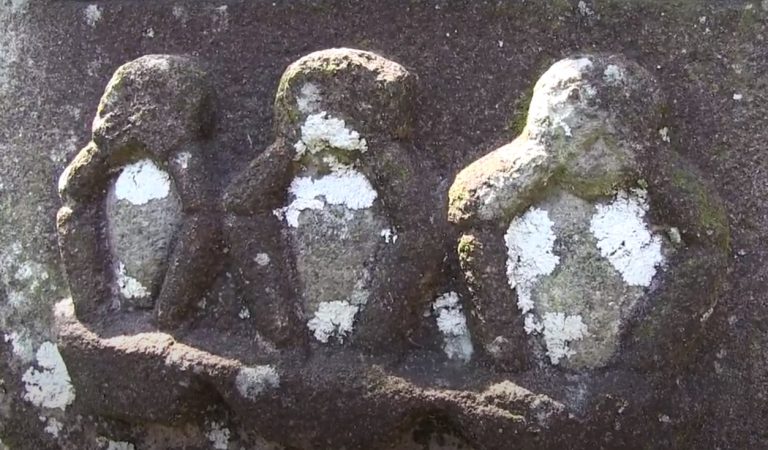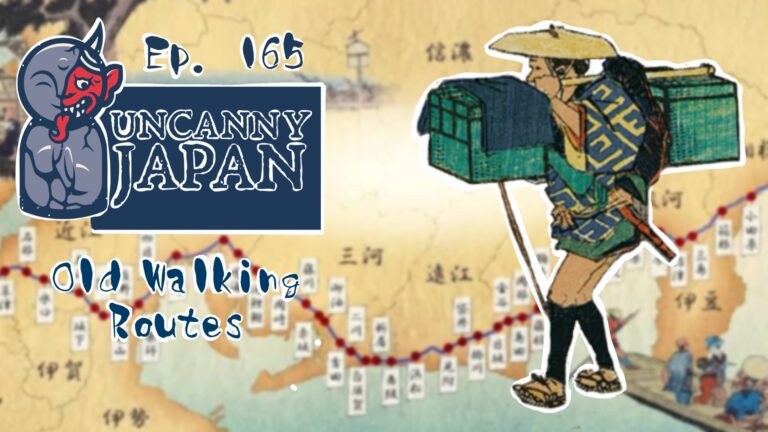Hey hey, this is Thersa Matsuura and you’re listening to Uncanny Japan.
What do you know about kitsune, Japanese foxes? I’d venture to say, a lot. We find foxes everywhere, games, manga, anime, artwork, guarding shrines, possessing people. I’ve been asked to do an episode on foxes, and I will. But first let me tell you about what I’m loving a little more than the fox at the moment. The wolf.
Or ookami in Japanese. Now let me ask you that same question differently: What do you know about Japanese wolves? Maybe not so much?
Well, let’s fix that for you today. Let me tell you what I’ve discovered about these stoic, beautiful and incredibly sadly now extinct creatures.
Intro:
Hello there, how are you? Have I told you how fantastic my patrons are recently? The other day Patron Bee came up with a brilliant idea that I want to share.
#Uncannytober
Does everyone know about Inktober? It was created by Jake Parker, an artist who wanted to help other artists to challenge themselves, improve their skills, and just get into the habit of creating something regularly. Originally (back in 2016) it was only ink drawings, but then as it took off it expanded to any medium. The idea is simple: You spend a bit of time drawing something related to one of his prompts every day in the month of October, then share it on the social media platform of your choice with the hashtags #inktober or #inktober and the year, and everyone can click around and see neat things.
It turns out it’s a lovely way to, yes, challenge yourself, but also meet other artists and get at little inspiration.
Jake Parker has already put up his own list of daily prompts over on his site, but I have heard of people riffing of idea in all sorts of ways. And that’s where Bee comes in. She went through and made a list of 31 different yokai from 31 different Uncanny Japan episodes and assigned them a day and said, hey, what you do think about us doing this.
Sam, remember from last episode, said there is actually a #Yokaitober which is cool, too. They’ve already got their list up.
But what I like about Bee’s idea is that she connected each yokai or ghostie with an episode of the show, so that if you’d like, you can listen, get into the mood of the creature, and then create your masterpiece. And share, let’s use #uncannytober. Why not? Let’s make October weird.
I’ll put up a separate page on the website called Uncannytober2022 that will have Bee’s list and links to the various shows. Richard mentioned if you want using the art with links back to the creator on each of the episodes being referenced.
Anyway, I’m going to try it out. I’m not an artist, by any stretch, so don’t be shy about sharing. I’d love to see everyone’s takes on the prompts.
The Wolf and its Name
Okay, let’s tiptoe back to our wolves. Wolf history and lore can get confusing, especially since, like I said, they’re no longer around anymore, so I’ll try not to wander too into the weeds. However, this is going to be a two parter because you have the wolf wolf, the actual animal and then you have the folklore and worship of them. There’s a lot to the wolf.
But first let’s start where we always start, the name. Ōkami/狼. If you’re familiar with Japanese you’ll notice it sounds like big god/大神. It’s not actually, although there is, of course, the thought that that’s where it comes from. These stoic animals are associated with godliness as well as being messengers for the gods.
A side note: It’s been suggested that the wolf was the messenger of the mountain gods while the fox was the messenger of the rice field gods.
If you look at the Japanese character for wolf/狼, ōkami, it’s a single kanji that consists of two parts. The left is called “kemono hen”, or the radical for wild animal. And on the right is ryō/良, or the character for good. A good animal. Isn’t that sweet.
Characters and names change through the ages and some beliefs as to the original meaning are: great spirit, big dog, big bite, or big mouth. Another is a variation of ōguchi no makami/大口の真神 /the true god with big a mouth. That’s my favorite. I’ll talk a little more about how that came about later.
But you’ll also hear and read about something called a yamainu/山犬 or mountain dog. There is a bit of a controversy about that. Is a yamainu another name for wolf or were they literally just wild dogs that lived in the mountains? I think I read for an entire day arguments back and forth before I finally stopped. I will, though, mention a certain Ono Ranzan, who wrote a book about natural studies in 1803 called Honzo Koumoku Keimou and in it he said the ōkami is an edible grayish brown animal with a long ash colored white tipped tail and webbed toes and triangular eyes. But the yamainu while similar has speckled yellowish fur, unwebbed toes and also it smelled really bad and you couldn’t eat it.
The thing is, even if they were different animals, the words ōkami and yamainu are often used interchangeably. You’ll also sometimes see ōinusama/お犬様, which is putting all the honorifics on the word dog. You can see how revered they were just from the naming.
Two Kinds of Wolves
Next, there were two distinct breeds of Japanese wolf. The Honshu Wolf which lived on the big island of Honshu as well as Shikoku and Kyushu, and then the Hokkaido Wolf or Ezo Wolf, which roamed the Northernmost island of Hokkaido and the Russian island north of that, Sakhalin. They are both sub species of the gray wolf.
Another thing is that Japanese wolves were smallish. Not the smallest wolves in the world, but definitely on the smaller side. For example, an Alaskan wolf can weigh about 60 kilograms, the Honshu okami was around 15 kilograms. The Hokkaido variety was a little bigger than that.
Speaking of Hokkaido wolves. The Ainu — the indigenous people of Hokkaido — worshiped the wolf as a deity called Horkew Kamuy (Howling God). One Ainu myth story says that of the Ainu people came about when a white wolf hooked up with a goddess. The Ainu had quite the reverence for their wolves. There are stories about how hunters would leave some of their kill for wolves to eat. How the Ainu would sometimes raise wolf cubs to actually become their hunting companions. How you couldn’t kill a wolf with a poison arrow or gun and if you wasted the animal’s pelt or the meat, other wolves would come to take revenge.
How I Became Interested in the Wolf – A True Story
Let me back up on minute and tell you a fascinating true story about how the ōkami came across my radar in the first place, but also it shows how even though the wolf has been extinct since 1905, they are not forgotten and still revered.
I have a student and friend who is in his early seventies and he told me this story about his daughter and what happened to her when she was really small.
It goes that as a baby she used to cry, especially at night. He and his wife worried about her, but all the trips to all the doctors said she was physically fine, just a baby who cried a lot and she’d grow out of it. But it went on. She eventually got to the age when she could talk and she started telling her parents that she was afraid of the dog that followed her around. They didn’t have any pets and had never seen any strays, so that concerned them. They asked for some more detail and she eventually told them at night a dog would show up at the window or in her room, and it scared her. Now her parents were really concerned. I’m not sure how they determined it, but it was decided that the dog was actually a fox or fox spirit. It was a kitsune being a jerk. Or worse, trying to possess her.
What would scare a fox away? Why, a wolf of course! They found an old wolf shrine (not an easy task in and of itself) but it was right here in the prefecture. It was quite hazardous to get to though. He said the very first time they went (this is pre cell phone, no signs, no maps, just the directions of a Shinto priest) they drove and drove and got terribly lost. At one point the road split and even though there were no houses anywhere up on this mountain, there was a little old woman sitting at the fork in the road. They said they got goosebumps. What’s she doing here? Where did she come from?
But they stopped and asked and she pointed them to the correct way. After that they reached the shrine/temple and paid it a visit. There they prayed and bought an ofuda, protective talisman, and that night hung it up by her bed. He said, no exaggeration, from that moment the night crying stopped. And stayed stopped. And her demeaner changed, too. When they asked she said the fox had gone away. My friend said they continued to go to this shrine which really is a harrowing drive, every year to buy a new ofuda for many years.
That story got me thinking about wolves. It also got me to make the trek to that shrine myself recently. But I’ll talk about that later.
Wolves.
Description of a Hokkaido Wolf
Here is how Edwin Dun described the Northernmost one in unpublished memoirs:
“The Hokkaido wolf is a formidable beast but not dangerous to man as long as other prey is to be had for the killing. During the winter months, at the time of which I am writing, they lived mostly upon deer which were very plentiful. During the summer their diet was principally horse meat. A full grown wolf weighs from 70 to 80 pounds, he has an enormous head and mouth armed with tremendous fangs and teeth. He is generally very lean but exceedingly muscular. Of a grey color in summer and greyish white in winter, when his fur is thick and long. His feet are remarkable for their size, three or four times larger than the feet of the largest dog which they resemble in shape, only the claws are much longer. Their large feet enable them to travel rapidly over deep snow that soon tires a fleeing deer that could easily run away from his enemy when the ground is bare. They usually hunt singly or in couple but frequently the trail of a pack of four or five or even more is seen in the snow. They are widely scattered throughout the island as a rule but few in any one neighborhood.”
Wolf as Protector/Wolf Charms
So you can imagine that ōkami were both worshipped and feared. Remember I said that they were the thought to be a kind of messenger of the mountain gods/山神/yama no kami? Well, it was also believed they were great protectors. It was the wolf who preyed upon boar, deer, nasty monkeys, and the like which were all animals that invaded and devastated villagers’ crops. The wolves were perfectly sated on this animals and really had not need to attack humans.
Wolves were powerful protectors and lucky, too. For example, wild boar were such a menace that people made charms called shishiyoke/獅子避け (shishi being a name of inoshishi, wild boar, and yoke meaning to keep away). What made these charms strong were the bits of wolf used, teeth and hide, something you could carry around with you when you were traipsing the mountains paths. Ever been charged and gored by a wild boar? Well, not if you have your wolf fang charm!
Even mountain ascetics or yamabushi/山伏 would roam the mountains with wolf fangs tucked into their robes. I didn’t quite understand this but Julyan’s girlfriend told me about one of these charms she’d found on yahoo auction that was sold for thousands of dollars. It’s not just always a single tooth, but the entire palate, upper or lower. So all the teeth. I’d like to believe those were collected after finding a wolf that died a natural death and some kind of ceremony was also performed.
So except for that, for hundreds and hundreds and hundreds of years, life in your village with wolves in the hills was a nice symbiotic relationship. Wolves hunted the annoying animals that wrecked your crops and you worshipped or at least paid them their due respect. Everything was fine until…
Extinction
The Hokkaido Wolf is said to have gone extinct in 1889 and the Honshu Wolf in 1905. Those are the agreed upon dates, although there have been claims of sightings and even the occasional photograph of a wolf or mountain dog.
So what happened. Several things, it seems. One is that both rabies and distemper were absent until the mid 1700s. Rabies showed up in 1736 in Eastern Japan.
Not only did the diseases hurt the population, now you have animals acting suddenly acting aggressively toward livestock and the farmers who kept them. In 1742 the first professional wolf hunters appeared.
There was also a uptick in the superstition that wolf parts gave protection and brought good luck, so they were hunted for their teeth, hides, and skulls.
Also, the Meiji Restoration happened. In 1868 Japan opened up and foreigners came in, Americans. Why not impose agricultural reforms? Why assign an American rancher from Ohio named Edwin Dun to fix everything? Yes, ranches. That’s what Hokkaido needed more of. Suddenly wolves were the bad guys. The Meiji government declared them yugai dobutsu/有害動物, yugai is poisonous, and doubutsu means animals. Wolf killing became a national policy. Mr. Dun was also put in charge to get rid of them and so strychnine laced bait was set out and the wolves, both the Honshu and the Hokkaido, who were stoic protectors for thousands of years, worshipped, feared, but respected were all wiped out.
It’s believed the last Japanese wolf was captured and killed in a village in Nara Prefecture January 23, 1905.
Some believe they survived on an island Sakhalin (that northmost Russian island until 1945.
There have been sightings throughout the years, but it’s believed that they are either hoaxes or a feral dog that has been misidentified. The Japan Times has a great series of articles called Japan’s Lost Wolves that talks about them and even the hopeful people who are dedicated to trying to find some who might still be existing deep in the mountains away from pesky humans.
But the wolf is not forgotten. There still exists shrines dedicated to the ōkami and like my friend and his daughter, people still visit and pay their respects. I’ll talk more about the shrines, legends, and other wolf lore in Part Two, next episode.
So I’ll leave you for now. If you’d like to try a daily doodle of some of the yokai and ghosties from past episodes, I’m putting up Bee’s list with links on the website it’ll be called Uncannytober2022. A heads up, October 1st will be umi bozu, episode 20 and October 2nd will be Kuchisake Onna episode 23. So get your pencils, pens, paint brushes, or anything at all ready.
Thank you for listening, please consider becoming a patron, if you’d like. For only five dollars a month you get obscure monthly folktales that I don’t talk about on the show, occasional recipes, MP3s of those nature sounds you hear in the background with no talking, the other day I found some neat information about fox money, or kitsune no koban and put up a post about that and I’ll put up more photos and information about the wolf shrine visit, too. So there is extra stuff over there. You can find it if you search for Patreon and Uncanny Japan. Thank you and I’ll talk to you more about wolves real soon.
Bye Bye







This episode hit hard with the extinction portions. With it being Uncanny Japan, I had this idea of the wolf temple being staffed by wolves that just appear human.
William, I agree. I get quite worked up when I talk about what happened to these beautiful animals. I had to cut quite a bit because I was just getting angry, sad, and depressed. I would love to visit that temple (wolves appearing as humans), I’ll have to visit some more and be sure to look carefully at the monks and staff who work there. There was NO ONE at this one. Which I understand, it is soooo out of the way. But there was an old building that used to house traveling monks (or temple visitors). It looked is disrepair, but I would love to stay there, if possible some day.